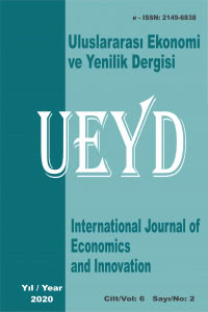Yeni Sanayileşen Ülkelerde Finansal Kuznets Eğrisinin Geçerliliği
Çalışmada, yeni sanayileşen ülkelerde 1987-2019 dönemi için Finansal Kuznets Eğrisi hipotezinin geçerliliği araştırılmıştır. Bu doğrultuda finansal gelişme ve gelir eşitsizliği arasındaki ilişki panel veri yöntemi kullanılarak incelenmiş, Parks-Kmenta ve Beck-Katz tahminleri gerçekleştirilmiştir. Elde edilen bulgular neticesinde yeni sanayileşen ülkelerde Finansal Kuznets Eğrisi hipotezinin geçerli olduğu, finansal gelişme ile gelir eşitsizliği arasında ters-U ilişkisinin varlığı tespit edilmiştir. Buna göre, yeni sanayileşen ülkelerde finansal gelişme belirli bir eşik düzeyine kadar gelir eşitsizliğini arttırmakta, bu eşik düzeyinden sonra gelir eşitsizliğini azaltmaktadır. Diğer taraftan kişi başına GSYH ve kişi başına GSYH karesi değişkenleri kontrol değişken olarak modele dahil edilmiş ve yeni sanayileşen ülkelerde klasik Kuznets Eğrisi hipotezinin de geçerli olduğu, kişi başına gelir ile gelir eşitsizliği arasında ters-U ilişkisinin olduğu sonucuna ulaşılmıştır. Yeni sanayileşen ülkelerde kişi başına gelir belirli bir eşik düzeyine kadar gelir eşitsizliğini arttırmakta, bu eşik düzeyinden sonra gelir eşitsizliğini azaltmaktadır.
Anahtar Kelimeler:
Finansal Kuznets Eğrisi, Finansal Gelişme, Gelir Eşitsizliği, Yeni Sanayileşen Ülkeler
Validity of the Financial Kuznets Curve in Newly Industrialized Countries
In the study, the validity of the Financial Kuznets Curve hypothesis was investigated for the period 1987-2019 in newly industrialized countries In this direction, the relationship between financial development and income inequality was examined using the panel data method, and Parks-Kmenta and Beck-Katz estimations were made. As a result of the findings, it has been determined that the Financial Kuznets Curve hypothesis is valid in newly industrialized countries, and the existence of an inverted-U relationship between financial development and income inequality. Accordingly, in newly industrialized countries, financial development increases income inequality up to a certain threshold level, and decreases income inequality after this threshold level. On the other hand, per capita GDP and per capita GDP squared variables were included in the model as control variables, and it was concluded that the classical Kuznets Curve hypothesis is also valid in newly industrialized countries, and there is an inverse-U relationship between income per capita and income inequality. In newly industrialized countries, per capita income increases income inequality up to a certain threshold level, and decreases income inequality after this threshold level.
Keywords:
Financial Kuznets Curve, Financial Development, Income Inequality, Newly Industrialized Countries,
___
- Akan, Y., Köksal, B. ve Destek, M. A. (2017). The financial kuznets curve in European Union. EconWorld2017@Rome Proceedings 25-27 January, Rome, Italy,1-6.
- Azam, M. ve Raza, S. A. (2018). Financial sector development and income inequality in ASEAN-5 countries: Does financial kuznets curve exists?, Global Business and Economics Review, 20(1), 88–114.
- Baltagi, H. B. (2013). Econonometric analysis of panel data. USA: John Wiley and Sons.
- Destek, M. A., Okumuş, İ. ve Manga, M. (2017). Türkiye’de finansal gelişim ve gelir dağılımı ilişkisi: Finansal kuznets eğrisi. Doğuş Üniversitesi Dergisi, 18(2), 153-165.
- Doğan, B. (2018). The financial kuznets curve: A case study of Argentina. The Empirical Economics Letters, 17(4), 527-536.
- Greenwood, J. ve Jovanovic, B. (1990). Financial development, growth, and the distribution of income. Journal of Political Economy, 98(5), 1076-1107.
- Hepsağ, A. (2017). Finansal kuznets eğrisi hipotezi: G-7 ülkeleri örneği. Sosyal Güvenlik Dergisi, 7(2), 135-156.
- International monetary fund (IMF). (2021). https://www.imf.org/external/index.htm (Erişim: 11.07.2021)
- Kuşçuoğlu, Yılmaz, Ş. ve Çiçek, M. (2021). Finansal gelişme ve gelir eşitsizliği ilişkisi: Türkiye’de finansal kuznets eğrisinin ARDL sınır testi ile analizi. International Journal of Scientific and Technological Research, 7(1), 79-102.
- Kuznets, S. (1955). Economic growth and income inequality. The American Economic Review, 45(1), 1-28.
- Nikoloski, Z. (2013). Financial sector development and inequality: Is there a financial kuznets curve?, Journal of International Development, 25, 897-911.
- Özdemir, O. (2021). Finansal kuznets eğrisi ve ekonomik küreselleşme ilişkisi üzerine: OECD ülkeleri için gelir eşitsizliği temelli bir analiz. OPUS-Uluslararası Toplum Araştırmaları Dergisi, 17(38), 5271-5303.
- Özdemir, O. (2019). Rethinking the financial Kuznets curve in the framework of income inequality: Empirical evidence on advanced and developing economies. Economics and Business Letters, 8(4), 176-190.
- Pata, U. K. (2020). Finansal gelişmenin gelir eşitsizliği üzerindeki etkileri: Finansal kuznets eğrisi hipotezi Türkiye için geçerli mi?, Atatürk Üniversitesi İktisadi ve İdari Bilimler Dergisi, 34(3), 809-828.
- Ridzuan, A. R., Zakaria, S., Fianto, B. A., Yusoff, N. Y. M., Sulaiman, N. F. C., Siswantini, M. I. M. R. ve Lestari, A. (2021). Nexus between financial development and income inequality before pandemic Covid-19: Does financial kuznets curve exist in Malaysia, Indonesia, Thailand and Philippines?. International Journal of Energy Economics and Policy, 11(2), 260-271.
- Satti, S. L., Mahalik, M.K., Nanthakumar, L. ve Shahbaz, M. (2015). Exploring the linkages between financial development and income inequality: Does financial kuznets curve exist in Kazakhstan?, Working Paper 2015-002, 1-32.
- Sayar, G., Erdaş, M. L. ve Destek, G. (2020). The effects of financial development, democracy and human capital on income distribution in developing countries: Does financial kuznets curve exists?. Journal of Applied Economics and Business Research JAEBR, 10(2), 76-95.
- SWIID, The standardized world income inequality database (2021). https://fsolt.org/swiid/ (Erişim: 11.07.2021)
- Tatoğlu Yerdelen, F. (2016). Panel veri ekonometrisi. İstanbul: Beta Yayımcılık.
- Tatoğlu Yerdelen, F. (2017). Panel zaman serileri analizi. İstanbul: Beta Yayımcılık.
- Tekin, İ. ve Cengiz, O. (2017). Nexus between financial development and inequality: An empirical investigation of financial kuznets curve for selected EU countries. The Empirical Economics Letters, 16(7), 687-696.
- Torusdağ, M. ve Barut, A. (2020). Çevresel ve finansal kuznets eğrisinin geçerliliği: Türkiye örneği. Maliye Araştırmaları Dergisi, 6(3), 125-135.
- Worldbank, World development indicator (WDI). (2021). https://databank.worldbank.org/data/ (Erişim: 11.07.2021)
- Yılmaz, V. ve Demirgil, B. (2021). Finansal gelişme ve gelir dağılımı eşitsizliğini incelemeye yönelik uygulamalı bir çalışma: Türkiye örneği. Giresun Üniversitesi İktisadi ve İdari Bilimler Dergisi, 7(2), 289-306.
- ISSN: 2149-6838
- Yayın Aralığı: Yılda 2 Sayı
- Başlangıç: 2015
- Yayıncı: Seyfettin Artan
